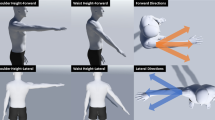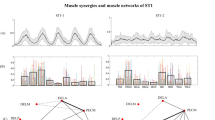Abstract
Childhood dystonia is a movement disorder characterized by muscle overflow and variability. This is the first study that investigates upper limb muscle synergies in childhood dystonia with the twofold aim of deepening the understanding of neuromotor dysfunctions and paving the way to possible synergy-based myocontrol interfaces suitable for this neurological population. Nonnegative matrix factorization was applied to the activity of upper-limb muscles recorded during the execution of writing tasks in children with dystonia and age-matched controls. Despite children with dystonia presented compromised kinematics of the writing outcome, a strikingly similarity emerged in the number and structure of the synergy vectors extracted from children in the two groups. The analysis also revealed that the timing of activation of the synergy coefficients did not significantly differ, while the amplitude of the peaks presented a slight reduction. These results suggest that the synergy analysis has the ability of capturing the uncorrupted part of the electromyographic signal in dystonia. Such an ability supports a possible future use of muscle synergies in the design of myocontrol interfaces for children with dystonia.







Similar content being viewed by others
References
Akaike, H. Factor analysis and AIC. Psychometrika 52:317–332, 1987.
Barry, M. J., J. M. Van Swearingen, and A. L. Albright. Reliability and responsiveness of the Barry-Albright Dystonia Scale. Dev. Med. Child. Neurol. 41:404–411, 1999.
Bernstein, N. A. The Coordination and Regulation of Movements. Oxford: Pergamon, 1967.
Bizzi, E., F. A. Mussa-Ivaldi, and S. Giszter. Computations underlying the execution of movement: a biological perspective. Science 253:287–291, 1991.
Buchanan, J. J., J. A. S. Kelso, and A. Fuchs. Coordination dynamics of trajectory formation. Biol. Cybern. 74:41–54, 1991.
Cheung, V. C. K., A. d’Avella, M. C. Tresch, and E. Bizzi. Central and sensory contributions to the activation and organization of muscle synergies during natural motor behaviors. J. Neurosci. 25(27):6419–6434, 2005.
Cheung, V. C. K., L. Piron, M. Agostini, S. Silvoni, A. Turolla, and E. Bizzi. Stability of muscle synergies for voluntary actions after cortical stroke in humans. Proc. Nati. Acad. Sci. USA 106:19563–19568, 2009.
Cheung, V. C. K., A. Turolla, M. Agostini, S. Silvoni, C. Bennis, and P. Kasi. Muscle synergy patterns as physiological markers of motor cortical damage. Proc. Natl. Acad. Sci. USA 109(36):1–5, 2012.
Clark, D. J., L. H. Ting, F. E. Zajac, R. R. Neptune, and S. A. Kautz. Merging of healthy motor modules predicts reduced locomotor performance and muscle coordination complexity post-stroke. J. Neurophysiol. 103(2):844–857, 2010.
d’Avella, A., L. Fernandez, A. Portone, and F. Lacquaniti. Modulation of phasic and tonic muscle synergies with reaching direction and speed. J. Neurophysiol. 100(3):1433–1454, 2008.
d’Avella, A., P. Saltiel, and E. Bizzi. Combinations of muscle synergies in the construction of a natural motor behavior. Nat. Neurosci. 6:300–308, 2003.
Golub, G. H., and C. F. Van Loan. Matrix Computations. Baltimore: Johns Hopkins University Press, 1983.
Hayes, H. B., S. A. Chvatal, M. A. French, L. H. Ting, and R. D. Trumbower. Neuromuscular constraints on muscle coordination during over-ground walking in persons with chronic incomplete spinal cord injury. Clin. Neurophysiol. 125:2024–2035, 2014.
Ivanenko, Y. P., R. E. Poppele, and F. Lacquaniti. Distributed neural networks for controlling human locomotion: lessons from normal and SCI subjects. Brain Res. Bull 78(1):13–21, 2009.
Kutch, J. J., A. D. Kuo, A. M. Bloch, and W. Z. Rymer. Endpoint force fluctuations reveal flexible rather than synergistic patterns of muscle cooperation. J. Neurophysiol. 100:2455–2471, 2008.
Lee, L., and D. Seung. Algorithms for non-negative matrix factorization. Adv. Neural Inf. Process. Syst. 13:556–562, 2001.
Lunardini, F., M. Bertucco, C. Casellato, N. Bhanpuri, A. Pedrocchi, and T. D. Sanger. Speed-accuracy trade-off in a trajectory-constrained self-feeding task: a quantitative index of unsuppressed motor noise in children with dystonia. J. Child. Neurol. 30(12):1676–1685, 2015.
Lunardini F., C. Casellato, M. Bertucco, T. D. Sanger, A. Pedrocchi. Muscle synergies in children with dystonia capture “healthy” patterns regardless the altered motor performance. In: Conf. Proc. IEEE Eng. Med. Biol. Soc., Vol. 2015, 2015, pp. 2099–2102.
Lunardini, F., C. Casellato, A. d’Avella, T. Sanger, and A. Pedrocchi. Robustness and reliability of synergy-based myocontrol of a multiple degree of freedom robotic arm. IEEE Trans. Neural. Syst. Rehabil. Eng. 24(9):940–950, 2015.
Lunardini, F., S. Maggioni, C. Casellato, M. Bertucco, A. Pedrocchi, and T. D. Sanger. Increased task-uncorrelated muscle activity in childhood dystonia. J. Neuroeng. Rehabil. 12:52, 2015.
Marsden, C. D., and J. C. Rothwell. The physiology of idiopathic dystonia. Can. J. Neurol. Sci. 14:521–527, 1987.
Rodriguez, K. L., R. T. Roemmich, B. Cam, B. J. Fregly, and C. J. Hass. Persons with Parkinson’s disease exhibit decreased neuromuscular complexity during gait. Clin. Neurophysiol. 124:1390–1397, 2013.
Roemmich, R. T., B. J. Fregly, and C. J. Hass. Neuromuscular complexity during gait is not responsive to medication in persons with Parkinson’s disease. Ann. Biomed. Eng. 42:1901–1912, 2014.
Roh, J., W. Z. Rymer, E. J. Perreault, S. B. Yoo, and R. F. Beer. Alterations in upper limb muscle synergy structure in chronic stroke survivors. J. Neurophysiol. 109:768–781, 2013.
Safavynia, S. A., G. Torres-Oviedo, and L. H. Ting. Muscle synergies: implications for clinical evaluation and rehabilitation of movement. Top Spinal Cord Inj. Rehabil. 17(1):16–24, 2011.
Sanger, T. D., M. R. Delgado, D. Gaebler-Spira, M. Hallett, and J. W. Mink. Classification and definition of disorders causing hypertonia in childhood. Pediatrics 111(1):e89–e97, 2003.
Takada, K., K. Yashiro, and M. Takagi. Reliability and sensitivity of jerk-cost measurement for evaluating irregularity of chewing jaw movements. Physiol. Meas. 27:609–622, 2006.
Torres-Oviedo, G., and L. H. Ting. Subject-specific muscle synergies in human balance control are consistent across different biomechanical contexts. J. Neurophysiol. 103:3084–3098, 2010.
Tresch, M. C., V. C. K. Cheung, and A. d’Avella. Matrix factorization algorithms for the identification of muscle synergies: evaluation on simulated and experimental data sets. J. Neurophysiol. 95:2199–2212, 2006.
Valero-Cuevas, F. J., M. Venkadesan, and E. Todorov. Structured variability of muscle activations supports the minimal intervention principle of motor control. J. Neurophysiol. 102:59–68, 2009.
Acknowledgment
We thank Serena Maggioni for assistance with data acquisition. We thank the patients and their families.
Funding
This work was supported by the National Institutes of Health (Grant Numbers NS064046 and 1R01HD081346-01A1).
Author information
Authors and Affiliations
Corresponding author
Additional information
Associate Editor Zahra Moussavi oversaw the review of this article.
Rights and permissions
About this article
Cite this article
Lunardini, F., Casellato, C., Bertucco, M. et al. Children With and Without Dystonia Share Common Muscle Synergies While Performing Writing Tasks. Ann Biomed Eng 45, 1949–1962 (2017). https://doi.org/10.1007/s10439-017-1838-0
Received:
Accepted:
Published:
Issue Date:
DOI: https://doi.org/10.1007/s10439-017-1838-0




